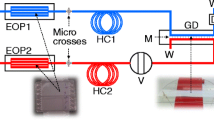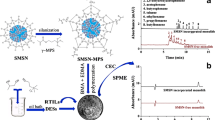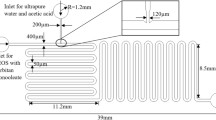Abstract
A high-pressure electro-osmotic micro-pump fabricated by a sol–gel process is reported as a fluid-driving unit in a flow-injection analysis (FIA) system. The micro FIA system consists of a monolithic micro-pump on a glass slide (2.5×7.5 cm), a micro-injector, and a micro-sensor (2.5×1.5 cm). The monolithic silica matrix has a continuous skeleton morphology with micrometer-sized through-pores. The micrometer-size pores with a large negative surface charge density build up a large pressure under a DC electric field to drive fluid through the downstream units. A novel Nafion joint for the downstream cathode eliminates flow into the electrode reservoir and further enhances pressure build-up. The measured pump-pressure curve indicated a maximum pressure of 0.4 MPa at flow rate of 0.4 μL min−1 at 6 kV. Despite the large voltage, the small current transmission area through the monolith produced a negligible current (less than 100 μA) that did not generate bubbles or ion contaminants. The flow rate can be precisely controlled in the range 200 nL to 2.5 μL min−1 by varying the voltage from 1 to 6 kV. The high pump pressure and the large current-free DC field also enabled the pump to act as an electro-spray interface with a downstream analytical instrument.








Similar content being viewed by others
References
Chen CH, Santiago JG (2002) J Microelectromech Syst 11:672–683
Zeng S, Chen CH, Mikkelsen JC, Santiago JG (2001) Sens Actuators B 79:107–114
Morf WE, Guenat OT, Rooij NF (2001) Sens Actuators B 72:266–272
Darabi J, Rada M, Ohadi MM, Lawler J (2002) J Microelectromech Syst 11:684–690
Lemoff AV, Lee AP (2000) Sens Actuators B 63:178–185
Laser DJ, Santiago JG (2004) J Micromech Microeng 14:R35–R64
Chen L, Ma J, Guan Y (2003) Microchem J 75:15–21
Liu S, Dasgupta PK (1992) Anal Chim Acta 268:1–6
Lazar IM, Karger BL (2002) Anal Chem 74(24):6259–6268
Lazar IM, Ramsey RS, Jacobson SC, Foote RS, Ramsey JM (2000) J Chromatogr A 892:195–201
Lastochkin D, Zhou R, Wang P, Ben Y, Chang H–C (2004) J Appl Phys 96:1730–1733
Minerick AR, Ostafin AE, Chang H-C (2002) Electrophoresis 23:2165
Mutlu S, Yu C, Selvaganapathy P, Svec F, Mastrangelo CH, Frechet JMJ (2002) In: Proceedings of the IEEE MEMS 2002 Conference, Las Vegas, USA, Jan 20–24, pp 19–24
Razunguzwa TT, Timperman AT (2004) Anal Chem 76:1336–1341
Tripp JA, Svec F, Frechet JMJ, Zeng SL, Mikkelsen JC, Santiago JG (2004) Sens Actuators B 99:66–73
Nakanishi KJ (1997) Porous Mater 4:67–112
Tanaka N, Kobayashi H, Nakanishi K, Minakuchi H, Ishizuka N (2001) Anal Chem 73(15):420A–429A
Chen Z, Hobo T (2001) Anal Chem 73:3348–3357
Chen Z, Hobo T (2001) Electrophoresis 22:3339–3346
Chen Z, Ozawa H, Uchiyama K, Hobo T (2003) Electrophoresis 24:2550–2558
Chen Z, Nishiyama T, Uchiyama K, Hobo T (2004) Anal Chim Acta 501:17–23
Chen Z, Uchiyama K, Hobo T (2002) J Chromatogr A 924:83–91
Chen Z, Hayashi K, Ywasaki Y, Kurita R, Niwa O, Sunagawa K (2005) Electroanalysis 17:231–238
Yeo LY, Lastochkin D, Wang SC, Chang H-C (2004) Phys Rev Lett 92:133902–133904
Lasen G, Velarde-Ortiz R, Minchow K, Barrero A, Loscertales LG (2003) J Am Chem Soc 125:1154–1155
Loscertales IG, Barrero A, Guerrero I, Cortijo R, Marquez M, Ganan-Calvo AM (2002) Science 295:1695
Acknowledgments
We thank Dr Albert E. Miller, University of Notre Dame, for use of his electrochemical instrument; Dr William Boggess, University of Notre Dame, for the injector used in this study, and Mr Katsuyashi Hayashi, NTT Microsystem Integration Labs, for valuable discussion on the sensor. This work is supported by the Center for Microfluidics and Medical Diagnostics at the University of Notre Dame.
Author information
Authors and Affiliations
Corresponding author
Rights and permissions
About this article
Cite this article
Chen, Z., Wang, P. & Chang, HC. An electro-osmotic micro-pump based on monolithic silica for micro-flow analyses and electro-sprays. Anal Bioanal Chem 382, 817–824 (2005). https://doi.org/10.1007/s00216-005-3130-7
Received:
Revised:
Accepted:
Published:
Issue Date:
DOI: https://doi.org/10.1007/s00216-005-3130-7




